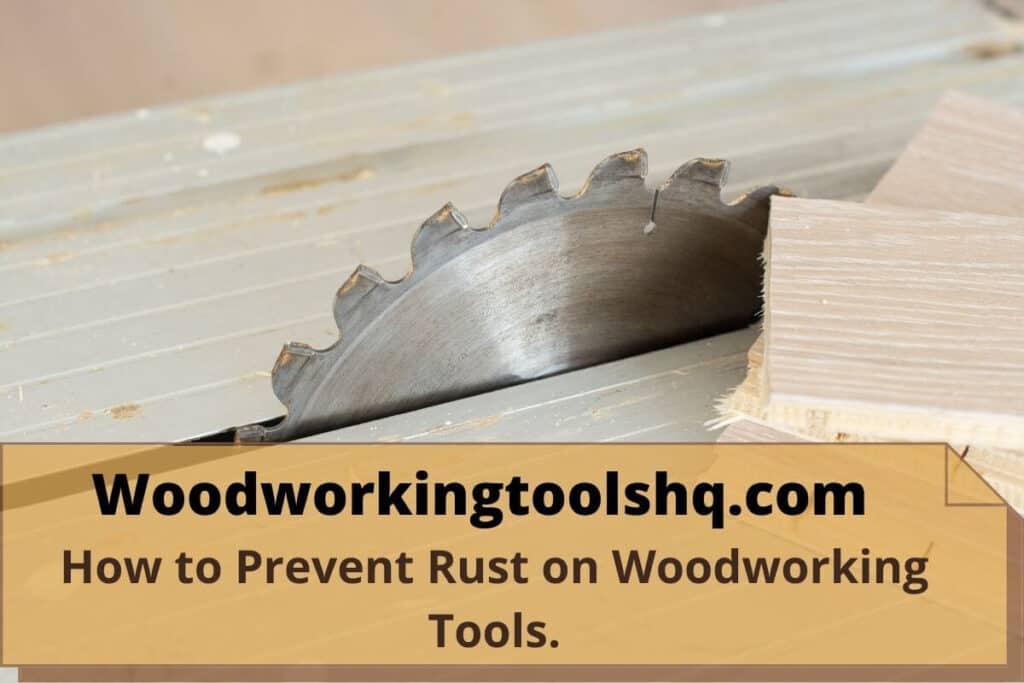Rust prevention on woodworking tools is very vital due to their relatively higher cost.
To increase productivity and get value from your tools, you must take good care of them.
A more considerable amount of tools used in most woodworking workshops are made of varying types of metal, and if not well maintained, they are prone to rust, especially when exposed to moisture.
Although some tools may be used after mild rusting, they won’t serve you for long as they will be rendered useless within no time.
Additionally, rusty tools look pretty unappealing.
So, to avert rust from stripping your woodworking tools of their functionality, below are practical and helpful hacks you can try:
Tips to prevent getting rust on your power tools
1. Frequently use your Tools
By and large, the most straightforward strategy to prevent your woodworking tools from rusting is by making maximum use of them.
Using your tools more often reduces the chances of them collecting moisture and dust, both of which are significant causes of rusting.
2. Reduce Moisture and Control Humidity
Controlling humidity and moisture is probably one of the most vital mechanisms that you can put in place to protect your woodworking tools from rust.
To achieve this, your workshop should be ventilated well.
However, if you mainly live in a humid climate and your workshop doesn’t get sufficient airflow, it will be ideal to invest in a dehumidifier of a fan.
A well-spaced and well-ventilated workshop will help avoid congestion of tools in one corner and help ensure that your tools are not exposed to rust-causing elements.
3. Arrange your Woodworking Tools Appropriately
To prevent your woodworking tools from rust, you should keep your workshop organized and neat.
It would be best if you separated power tools from hand tools. You avoid placing your tools on the floor as this could expose them to moisture and dust.
Ideally, you could put them on the shelves or hang them on the wall.
4. Install a Dust Collector
Dust is a potential cost of rust to your woodworking tools.
As you undertake various projects in your workshop, sawdust is always produced, which could make your workplace messy and dusty.
To avoid this, it would be ideal if you installed a dust collector in your workshop.
Additionally, you should always sweep and eliminate sawdust.
You could also place a slightly wet mat under your workbench; this helps trap dust as you work.
Chances of your woodworking tools being exposed to dust will be significantly reduced.
5. Use Silica Gel Packs
Another approach to prevent rust on your woodworking tools is by placing silica gel packs in your tool chest, toolbox, and in any place that you store your hand tools.
Although silica gel packs are often used in new shoe boxes, you can use them in your workshop to absorb moisture.
They are pretty simple to use, toss some in your toolbox, and you wouldn’t have to worry about rust in your woodworking tools.
However, it is important to note that they should be “recharged” more often; you will need to bake them for at least three hours in your oven at 240 degrees Fahrenheit.
6. Regularly Wipe your Woodworking Tools
As you undertake your various woodworking projects, you must regularly wipe your woodworking tools to eliminate dust and moisture.
This practice will go a long way in ensuring that your hard-earned tools are not exposed to rust-causing elements.
7. Apply Protective Coatings
This is one of the most practical and effective strategies to inhibit rust.
You are required to apply a tinny layer of non-oxidizing oil on your woodworking tools, including mineral oil. WD-40 and motor oil are also used by some woodworkers to achieve the same result.
However, it is essential to note that dust is attracted by oil; thus, you still need to conduct regular tool maintenance even after smearing a protective layer like oil.
If you do not prefer oils as your rust-protection preference, you should consider paste as another worthwhile option.
How to Remove Dust from your Woodworking Tools
Unfortunately, if you fail to maintain your tools regularly, they will be exposed to rust.
Fortunately, there are a number of ways that you could use to remove rust from your tools:
1. Use Vinegar
Vinegar is one of the ideal ways to get rid of rust from woodworking tools.
Its all-natural and powerful elements offer a means to remove rust even on thicker surfaces.
You can directly smear the vinegar to your tools or sock a duster with it and scrub.
The point is to let the vinegar get in contact with the rusted surface and adequately soak in there. Upon scrubbing, the rust is expected to come off quite nicely.
2. Use Rust Remover Chemical
Rust remover agent including Evapo-Rust to remove rust from the surface of your woodworking tools.
You are required to apply this chemical on the rusted surface and let it soak in.
After some minutes, you should scrub it, and the rust will come off.
When using this method, you are supposed to quickly smear rust inhibitor on your tools to reduce the chances of rust reoccurrence.
3. Sanding Block
Sanding blocks is one of the best remedies in getting off the rust from your wood cutting tools.
Apart from being powerful, it can get into finer areas where rust could build up fast. Sanding blocks could be applied directly to the woodworking tools.
However, it would be best if you were keen not to hit the actual coating as this could damage your tools.
It is essential to note that the sanding blocks should get deep on the rusted surfaces and connect adequately before scrubbing them.





